- Home
- Media Kit
- Current Issue
- Past Issues
- Ad Specs-Submission
- Ad Print Settings
- Reprints (PDF)
- Photo Specifications (PDF)
- Contact Us
![]()
ONLINE
![]()
ONLINE

Creating Place
Firm Brief
Kohn Pedersen Fox Associates (KPF) is one of the world’s preeminent architecture firms, providing architecture, interior, programming and master planning services for clients that include some of the most forward-thinking developers, corporations, entrepreneurs, and institutions in the United States and around the world. The firm’s extensive portfolio spans more than 40 countries and includes a wide range of projects from office and residential buildings to civic and cultural spaces to educational facilities. Driven by individual design solutions, rather than a predetermined style, KPF’s mission is to create buildings and places of the utmost quality and contextual sensitivity, providing a valuable impact on the cities they inhabit.
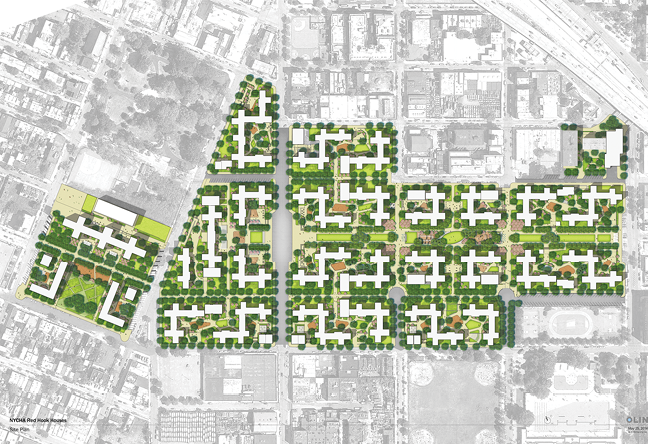
KPF’s resiliency plan for the NYCHA Red Hook Houses
creates pedestrian spaces, courtyards, and playgrounds,
and aids in wayfinding.
KPF’s culture is built on a clear set of values. Will you highlight the firm’s values and how critical the firm’s culture is to the strength and success of KPF?
We strongly believe that architecture can be an agent for improving the quality of life and changing our society for the better. Our core values include promoting universal access to a high-quality public realm, advocating for a more sustainable environment, and encouraging the freedom of expression in all who work with us. To support these goals, we have kept a comparatively flat hierarchy within the firm and have supported colleagues in pursuing new social initiatives.
What do you see as a company’s responsibility to the communities it serves and will you highlight KPF’s commitment to corporate responsibility and community engagement?
Buildings – both new and renovated – have a lasting impact on their communities, often standing for many decades. So, the design itself must work not only for the intended purpose of the current user, but must also contribute to the surrounding context. KPF is committed to creating places loved by users and neighbors alike. We take that responsibility seriously, engaging local community members from the earliest stages of the design process, sharing our ideas and spending time to build trust and to better understand their needs. At NYCHA Red Hook Houses in Brooklyn, we held numerous workshops with residents, elected leaders, parents, and even children, in order to craft a design for the public spaces that was both resilient and usable. Our plan improves building entries and site lighting, creates pedestrian spaces, courtyards, and playgrounds, and aids in wayfinding across this large expanse of repetitive, circa 1930s structures.
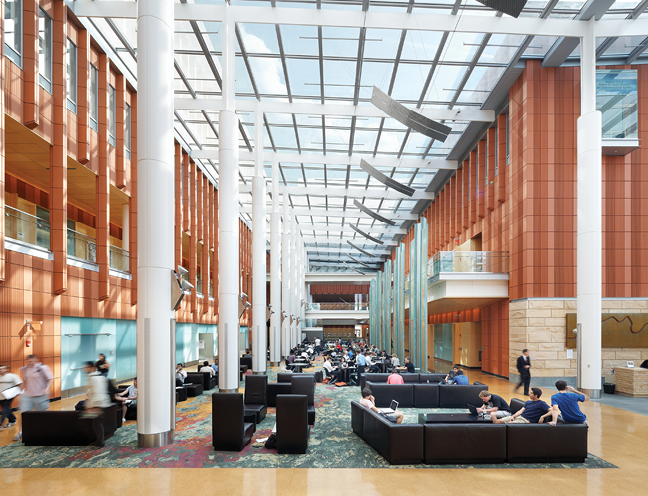
The central “living room” at the Ross School of Business
at the University of Michigan has become students’
preferred place to meet, study, and eat.
How do you describe the impact that architecture can make on the productivity and emotional well-being for the users of a building?
Physical spaces have an enormous impact on one’s day to day productivity and emotional health. In designing our academic buildings, for example, we create spaces that are comfortable, functional, and even inspirational. At the Ross School of Business, we designed a central hub for the campus that is, in effect, the living room of the school. Students prefer to spend time there – to meet, gather, study, work, eat – it has been truly transformational. The space’s connection to nature, careful use of materials, noise reduction, quality lighting, comfortable furniture, and substantial artwork all combine to enhance productivity and promote collaboration. These principles translate across KPF’s work at all scales, enhancing wellness and productivity while reducing stress – from the workplace to the hospital waiting room.
“KPF is committed to creating places loved by
users and neighbors alike. We take that responsibility seriously, engaging local community members from the earliest stages of the design process, sharing our ideas and spending time to build trust and to better
understand their needs.”
How does KPF support its people in their desire to give their time and expertise to addressing societal issues and causes?
KPF has in place a number of initiatives that allow staff to advance and advocate for a variety of important causes and to ensure these issues are considered in our firm’s designs. For example, KPF Public is a platform to address issues of racial and social inequality and combat the inequities that exist within the profession and the built environment; KPF Pride works to raise awareness of LGBTQ+ issues within the firm in ways that will inform design thinking; and KPF+ is dedicated to enabling women to achieve their full potential at work and to advancing gender equity in leadership.
We believe these activities and others provide a well-balanced experience for our staff that is germane to their work, and that an informed and engaged team is critical to KPF’s success as a global practice. These matters are integral to who our staff are and the firm’s support is a recognition of the individual. Ultimately the collective action of the staff will inform our mission as a global architecture firm.
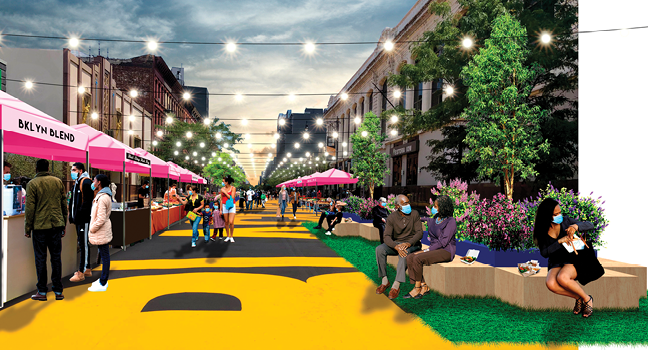
KPF, with support from KPF Public, joined the
Bedford-Stuyvesant Restoration Corporation and design partners
to create public space as part of the Neighborhoods Now
program to channel pro bono resources from New York-based
design firms into community-driven COVID-19 recovery strategies.
How critical is it for KPF to build a diverse and inclusive workforce in order to bring diverse perspectives and experiences to the table when addressing client needs?
KPF is a global firm and our reach is broad. To be competitive and effective, we must stay current, relevant and sensitive to all places and people we work with. We understand that in order to provide the best architectural solutions, our designers must be reflective of the populations they serve and so we recruit and retain staff to that effect. We are also seeing our clients and collaborators double down on ambitious diversity, equity, and inclusion goals of their own, so it is exciting and encouraging to see this shift across the broader industry.

KPF+ curated a month-long installation in the
New York office to celebrate Women’s History Month 2020.
Will you discuss the involvement of KPF staff to advise high school students with aspirations to pursue careers in design and construction through the ACE Mentor Program of America?
For more than 20 years, KPF has been an active leader and sponsor of the ACE Mentor Program of America in New York City. We do this to ensure we expand awareness of, and access to, opportunities within the profession to the next generation of architects. Each year, a committed team of KPF staff leads a series of after school sessions for a diverse group of local high school students interested in exploring careers in architecture, engineering, and construction. We work through hypothetical projects together, along with our colleagues on the developer side as well as our ACE partners, to simulate the roles we each play in the industry.
Our shared mission is to educate, inform, and inspire these students about opportunities available in these industries and to support their continued advancement throughout their academic career. We remain connected with the students as they move on to college, offering summer internships in our New York office and, ultimately, considering them for full-time positions upon graduation.
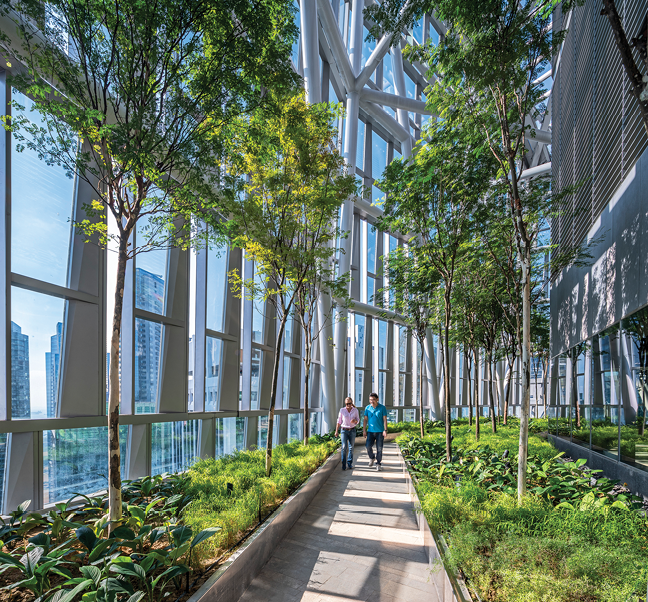
KPF’s design for 18 Robinson supports Singapore’s Landscape
Replacement Policy, replacing all greenery lost due to
development with equal area of publicly accessible green space.
What was the vision for creating the KPF Traveling Fellowship?
The traveling fellowships give us a chance to make a huge difference in the career of young architects through supporting their travel and independent study. We want them to be bold, take chances, and broaden their view of the world. This is a formative stage of their intellectual lives, and we want to give them the freedom to explore.
Will you highlight the creation of the KPF Paul Katz Fellowship, an international award established in honor of the life and work of former KPF Principal Paul Katz?
The Paul Katz Fellowship is an internationally competitive award established and administered by the KPF Foundation in honor of the life and work of former KPF President Paul Katz. It is given each year to assist international students in their pursuit of studying issues of global urbanism upon graduation from a masters of architecture program from the five East Coast schools at which Paul studied or participated as a teacher: Princeton, Yale, Harvard, Columbia, and the University of Pennsylvania.
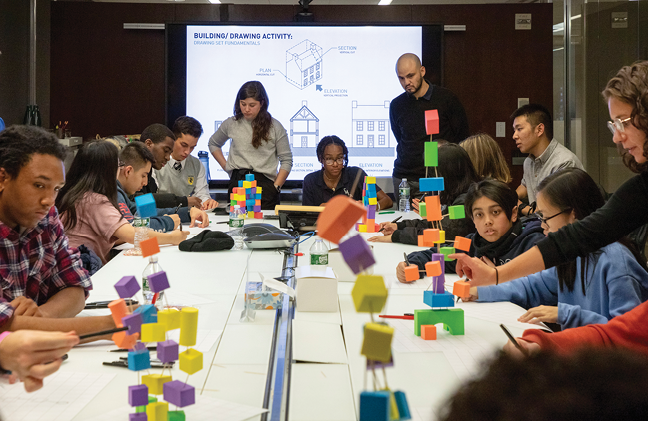
Through the ACE Mentor Program of America, KPF staff
advise high school students with aspirations to pursue
careers in design and construction.
Paul Katz’s career focused on the realization of large, complex, mixed-use projects in high-density, center-city locations. Projects he helped bring to life include: Roppongi Hills, a large mixed-use complex in Tokyo; many of the buildings at Canary Wharf in London; Hudson Yards in New York; the expansion of Covent Garden in London; and the renovation and repositioning of The Landmark complex in Central, Hong Kong. He was instrumental in building the current global structure and reach of KPF.
The breadth of the Fellowship is intended to celebrate Paul’s interest in the advancement of the global city. The Fellowship is permanently endowed through the generosity of people who worked closely with him, including friends, clients, colleagues, and KPF.
“We acknowledge that our buildings on their own
will not be able to achieve our ambitious climate
action goals, but by implementing design solutions
at all scales that integrate with and enhance mobility systems, energy and water infrastructure, and microclimates around them, we take advantage
of scale to positively impact the environment
beyond a project’s site and brief.”
Will you highlight KPF’s commitment to sustainability and how the large scale and impact of KPF’s work shapes the firm’s approach to sustainability?
For KPF, it is the large scale and impact of our work that shapes our approach to sustainability. Often urban and dense mixed-use developments, our projects are located in some of the fastest growing cities in the world, where architecture can be exponentially more impactful. We acknowledge that our buildings on their own will not be able to achieve our ambitious climate action goals, but by implementing design solutions at all scales that integrate with and enhance mobility systems, energy and water infrastructure, and microclimates around them, we take advantage of scale to positively impact the environment beyond a project’s site and brief.
The firm has joined AIA, RIBA, and many of its peers in a joint effort to develop the capabilities to design and deliver carbon-neutral buildings by 2030. Our sustainability mission includes our campus and community as we endeavor to achieve operational carbon neutrality by minimizing our energy, water, and waste impact and investing in the World Wildlife Fund’s Climate Crowd and Alliances for Climate Action programs.
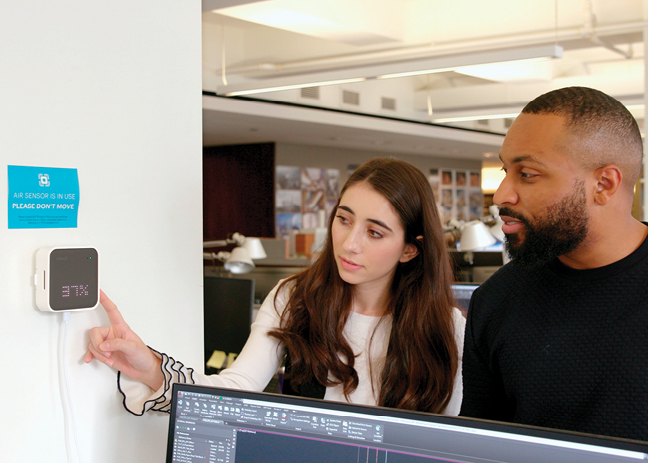
Members of KPF’s Green Design, Resilience, and Wellness (GRoW)
group monitor air quality sensors in the firm’s New York office.
What are your priorities for KPF as you navigate this challenging and unprecedented time?
The pandemic period has given us all a chance to see our work in perspective. The events following the killing of George Floyd have made it more important for us to call for societal change. Architecture can play a role in this. We’ve taken on significant pro bono work focused on helping disadvantaged neighborhoods to reopen their doors. We’ve also been intensifying our practice in the area of labs and life sciences, spurred on by the need to combat viral attacks.
More and more, our architectural community seeks to fulfill the higher goals of our profession - servicing not only our clients and building users, but also the general public and the planet. As we begin sketching the solution for any new project, we ask ourselves about the “externalities” of a given design solution. The challenges of dealing with climate change, health threats, social inequality and lack of accessibility to public benefits are monumental in scale, but by beginning with concrete and tangible measures, our work can make incremental differences.![]()